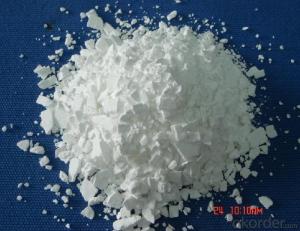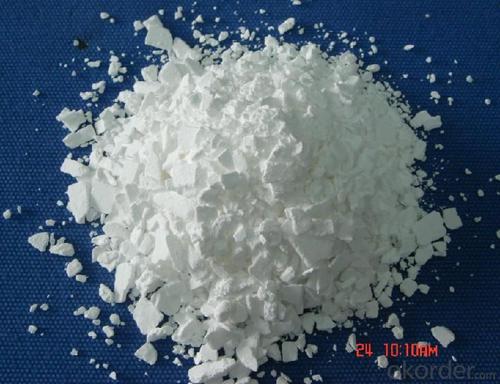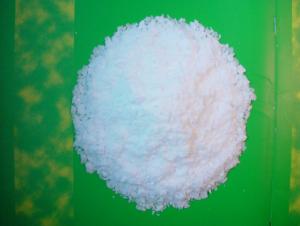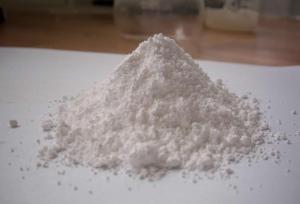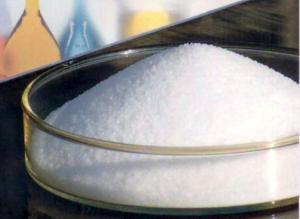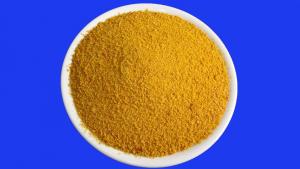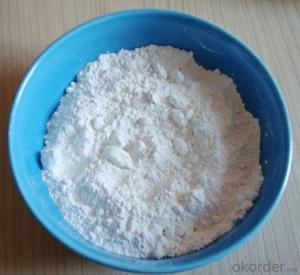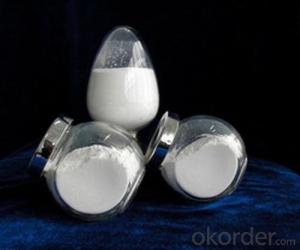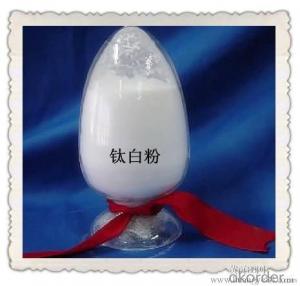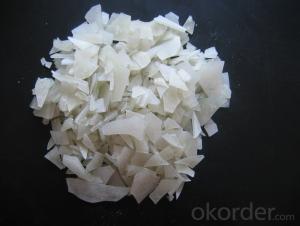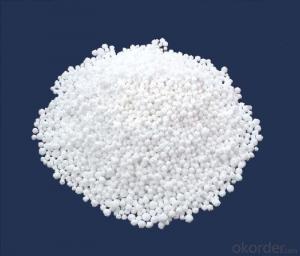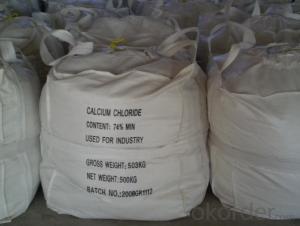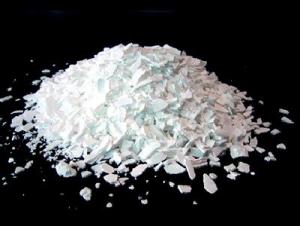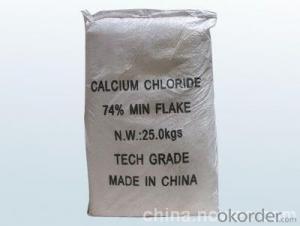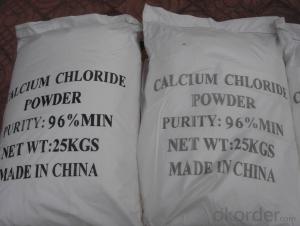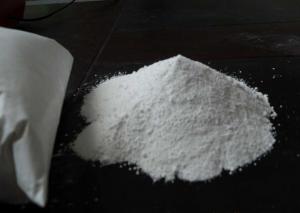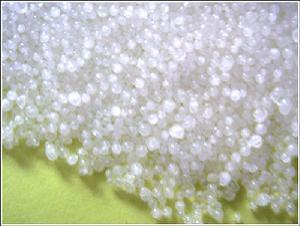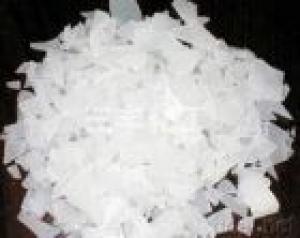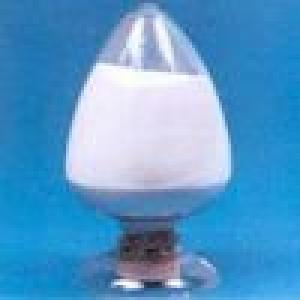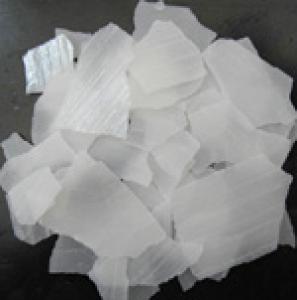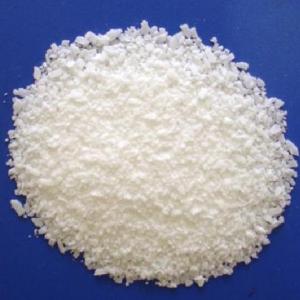Calcium Chloride with High Quality and Best Offer
- Loading Port:
- China Main Port
- Payment Terms:
- TT or LC
- Min Order Qty:
- -
- Supply Capability:
- -
OKorder Service Pledge
OKorder Financial Service
You Might Also Like
1. Structure of Calcium Chloride Description:
Property: White flake or grain crystal, its solubility is strong; Easy to dissolve in water. It has causticity.
Molecular Formula: CaCL2 , CaCL2 .2H2O
Molecule Weight: 110.98 , 147.01
CAS No.: 10043-52-4
Appearance: White Flakes / Ball / Powder/Granular
2.Main Features of Calcium Chloride:
calium chloride anhydrous ,cacl2 74% calcium chloride
Calcium chloride is an inorganic salt, which exists as solid or liquid. Solid calcium chloride is a white, crystal
3.Calcium Chloride Images



4.Calcium Chloride Specification
Item (Industrial Grade) | Quality Index | |
Purity ( As CaCL 2 ) | 74-77% | 90-94% |
Sulphate ( As CaSO 4 ) | 0.2 % max | 0.2% max |
Magnesium & Alkali Metal Chlorides ( As NaCL) | 3.5% max | 4.0% max |
Alkalinity ( As Ca(OH) 2 ) | 0.2% max | 0.25% max |
Water insoluble | 0.1% max | 0.2% max |
Item (Industrial Grade) | Quality Index | |
Purity ( As CaCL 2 ) | 74-77% | 90-94% |
Sulphate ( As CaSO 4 ) | 0.2 % max | 0.2% max |
Magnesium & Alkali Metal Chlorides ( As NaCL) | 3.5% max | 4.0% max |
Alkalinity ( As Ca(OH) 2 ) | 0.2% max | 0.25% max |
Water insoluble | 0.1% max | 0.2% max |
Arsenic ( As ) | 0.0002% max | 0.0002% max |
Heavy metals ( As Pb ) | 0.0005% max | 0.0005% max |
5.FAQ
1)How many tons does your factory can supply each moth?
30000tons/month
2)How to quarantee the quality of the products?
you can arrange SGS&BV or other quality inspection.
3)How many days you need to pepare the cargo after we made the order?
within 30 days.
- Q: Who can tell me what is plant alkalinity?
- (Sodium bicarbonate) (chemical formula Na2CO3) and baking soda (sodium bicarbonate) (chemical formula NaHCO3), baking soda is a solution of soda ash or crystal absorption after the carbon dioxide Of the finished product, the two are essentially no difference. Therefore, edible alkali in some places also known as baking soda (powder). Edible alkali is solid state, round, color white, soluble in water. Alcohol is not a commonly used condiment, it is just a food loose agent and meat tenderener, can make dry goods raw materials quickly rise, soften the fiber, remove the dough's sour taste, the appropriate use can bring excellent food The color, smell, taste, shape, to enhance people's appetite. Alkaline used in a large number of food processing such as noodles, bread, bread and so on.
- Q: Oxygen is not simple
- Yes. Because there is only one element of pure matter
- Q: give me at least 5 substances
- an inorganic substance usually contains no C NaCl refer to salts list and an organic does usually CH4 C2H6 C3H8 C4H10 C5H12 acids usually release H+ ions H2SO4 CH3OOH HCl H3SO4 HF bases usually release OH- ions NaOH Mg(OH)2 KOH LiOH Ca(OH)2 salts are usually just ionic compounds NaCl KCl NaI KI NaBr
- Q: Recently felt the whole body are sore, is not the relationship between the movement?
- In addition, if you do not exercise for a long time, then, should be gradual, do not hurry, so as not to damage the body, bring a negative impact ...
- Q: Definition of inorganic salts
- In addition to hydrogen, oxygen, nitrogen, carbon, sulfur, organic compounds other than organic compounds are collectively referred to as inorganic salts. The inorganic salts required by the human body, according to the content in the body, divided into essential elements (hydrogen, oxygen, nitrogen, , Magnesium, phosphorus, chlorine, potassium, sodium 11) in the human body content, the need for larger also known as macro elements of the source 2, the rest of the various elements, regardless of content, can be collectively referred to as inorganic salts. More elements such as iron, magnesium, potassium, sodium, phosphorus, sulfur, chlorine and other elements, other elements such as iron, copper, iodine, zinc, manganese, drilling, etc., due to the existence of a small number, and some even trace Known as trace elements, 3, what is the "inorganic salt", the body contains elements in addition to carbon, hydrogen, oxygen three elements mainly in the form of organic matter, the rest of the various elements are in the form of inorganic matter, collectively referred to as inorganic Salts such as calcium, magnesium, potassium, sodium, phosphorus, scratch, sulfur and the like
- Q: Which solvents have some solubility in inorganic salts
- A wide variety of dyes, dissolved complex. The original dyes are organic, but some salt, some metal complexes, some of the larger molecules of the fused ring compounds, some polymer heterocyclic compounds, in some common organic solvents in the solubility is better than disperse dyes Raw dyes and oil-soluble dyes (this is actually the raw material of solvent pigments, strictly speaking, not dyes). There are basically additives in the finished dyes, such as direct dyes, acid dyes, reactive dyes, cationic dyes and other water-soluble dyes will be added inorganic salts, disperse dyes, reducing dyes will be added sulfonate sodium dispersant. In addition, the dye and other chemical products, their purity requirements are generally very low, will allow the presence of certain insoluble impurities. So the organic solvent can not be completely dissolved dye products really is very common or even a normal phenomenon.
- Q: how come a penny can hold more drops of the salt water solution than just plain tap water from your faucet?
- Put in in a narrow tube. The narrower it is, the more surface tension it has at the meniscus.
- Q: Seaweed, kelp, shrimp and other seafood, the content is more of the kind of inorganic salts
- Kelp more Oh
- Q: What are organic and inorganic salts?
- Salt is a mineral from the Earth. Salts similar to iodized are extra munufactured and aren't fully typical. However salts like sea salt have the leat amount of processing. Some say that sea salt is healthier since it's he most traditional state of salt that you could get in mass production. I wolud must agree with them.
- Q: What are the nutritional requirements for bacterial growth?
- For inorganic salts: bacteria need a variety of inorganic salts to provide a variety of elements of bacterial growth, which requires the concentration of 10.3 ~ 10.4mol / L elements for the common elements, the need for concentration in the
Send your message to us
Calcium Chloride with High Quality and Best Offer
- Loading Port:
- China Main Port
- Payment Terms:
- TT or LC
- Min Order Qty:
- -
- Supply Capability:
- -
OKorder Service Pledge
OKorder Financial Service
Similar products
Hot products
Hot Searches
Related keywords
